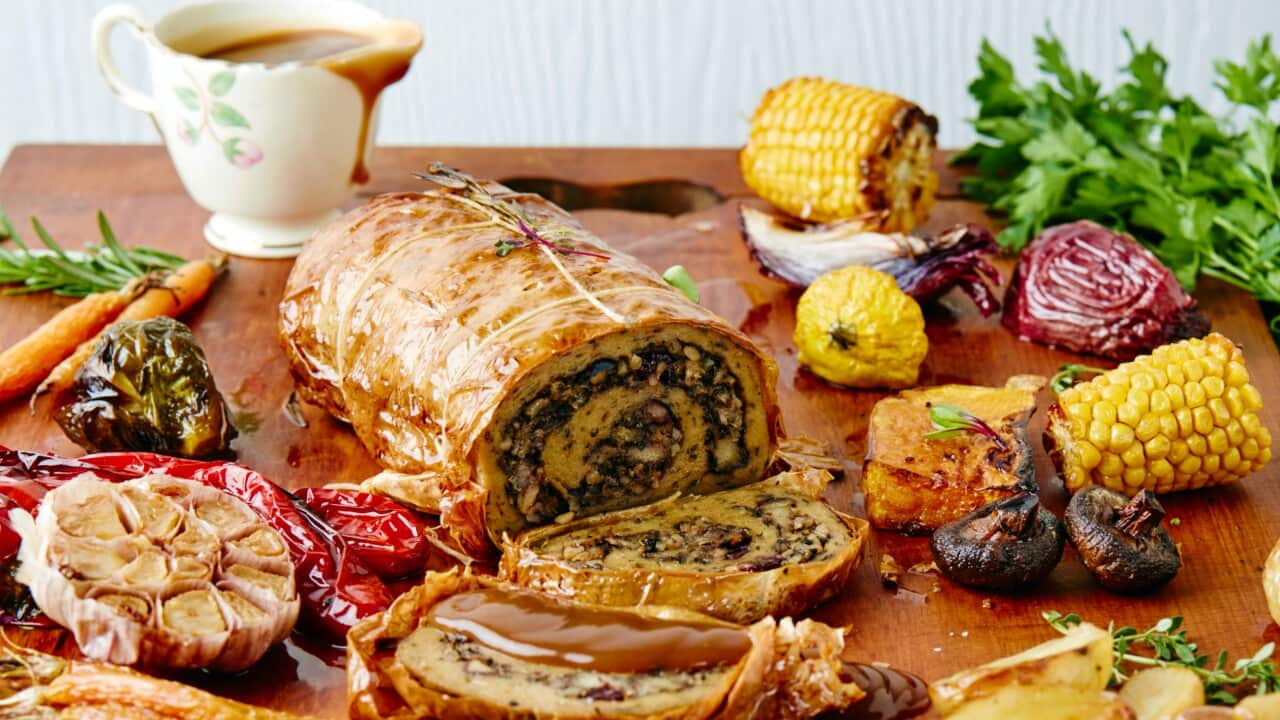Although seasonal advertising from our major supermarkets would have you think that we’re all eating roast turkey and mince pies for Christmas, traditional holiday fare in Australia is really as varied as our culturally diverse population.
From a German Christmas goose to Filipino roast pig, the centrepiece meals that annually decorate our dining tables are colourful, meaningful and awash with symbols of our ancestry.
SBS takes a sneak peek into the Christmas food traditions from three multicultural households in Australia.
A Latino Christmas feast
Paula Correa, who lives in Sydney’s northwest, tells SBS her family sticks to Latino food traditions, celebrating the season with a summery Christmas feast, served fresh on Christmas Eve.
There’s usually a few of us of who contribute to the cooking: myself – I am first generation Australian, as my parents were born in Argentina and Uruguay; my mother-in-law who is from Uruguay; and my sister-in-law who comes from El-Salvador. Together, we make a Latino feast for all our immediate and extended family.
We usually make asado, which consists of beef, chicken and pork cooked over charcoal, and pork chorizo. However, this year because of the fire ban, we will be making chicken schnitzel instead. We’ll serve a South American style of potato salad that has been traditional in my family for many years, along with tomatoes stuffed with tuna and rice, garnished with mayonnaise and an olive.
For dessert, we eat fruit salad, South American crème caramel and a Postre Chaja named after the Chaja bird also known as the southern screamer. It is made of sponge, meringue, peaches, whipped cream and dulce de leche.
This style of feast is all I’ve ever known. I didn’t grow up with a turkey for Christmas, which I understand is traditionally served in many countries within the northern hemisphere.
South America celebrates Christmas in summer, just like we do in Australia. So the foods we eat traditionally really aligns with the Aussie seasons. They may taste of South America but they are Australian.
Middle Eastern cuisine meets Australian fare
Jenane Azzi was born in Lebanon but moved to Australia with her family when she was a child. So although she’s spent many Christmas’s in Australia, her cultural heritage and food traditions are mostly Lebanese.
Each year, my family come together to celebrate for a Christmas Eve dinner. There’s always enough food to go around, no matter how many people come to dinner.
We usually have a full spread of prawns, tabbouleh, hummus and turkey, flavoured with Lebanese spices, stuffed with rice and nuts. Sometimes we make a smoked ham and additional summer salads but that usually depends on how many people – extended family and friends – we need to cater for.
Having a traditional 'Western-style' meal sometimes helps us to bridge the gap between our many cultures.
For dessert, it’s traditional in our family to blend Australian and Lebanese foods. We’ll always a have a fruit platter full of cherries, watermelon, mangoes and other summer fruits.
That will be served alongside kanafeh, a rich Middle Eastern dessert made with layers of pastry and cheese, soaked in sweet syrup. My sister has started to make it in recent years, so technically this dish is a new addition to our spread, but it’s one that’s stuck because it’s so delicious.
A traditional European Christmas cake may also be on offer, as well as a pavlova (made without a lot of cream).
Looking back at our Christmas feasts past, I see how our dinners have evolved over time. What was probably once a Lebanese spread, made when we were kids, is now a diverse blend of Australian and Middle Eastern cuisines, representing where we live now and also where we have come from.
A Russian-Chinese-Ghanian Christmas
Lilia Alex, who hails from Chinese-Russian parents, has a partner from Ghana. So her Christmas feasts truly represent the epitome of cultural diversity, and how food from around the world can merge with new Australian traditions.
When I was little in the 1980s, I used to spend Christmas at my babushka’s Russian Pentecostal Church in Lidcombe, NSW. We would have morning service that would lead to a big lunch full of KFC, Uyghur carrot pulao (rice) and other pot-luck food people from the church would bring for us all to eat.
Afterwards, all the children would receive a big bag of Russian lollies filled with lots of peanuts and almonds.
As I grew older, our family tradition changed. Dad would pick mum and me up from church and we would head off to dine on a fancy Chinese meal at a restaurant with crabs, prawns and a few other favourite dishes.
Since I’ve had children, we’ve mostly spent Christmas at home. That usually requires a whole day of cooking to make lunch and dinner. For lunch, we have our favourite cola glazed ham and potato salad. Dinner usually consists of a traditional roast turkey with all the trimmings like roast veggies and gravy, as well as a pavlova for dessert.
But on Christmas Eve my partner (who is from Ghana) will join his dad and sister, who visit us, to make a traditional Ghanaian Okra crab and fish soup, which is very spicy – but so delicious. My partner will also make fufu (made from semolina) to dip into the soup.
While we do have a traditional ‘Australian’ Christmas meal most of the time, we do like to mix it up occasionally, so the kids can experience something from both a Chinese/Russian culture on my side and Ghanaian culture on my partner’s side. Having a traditional 'Western-style' meal sometimes helps us to bridge the gap between our many cultures.









